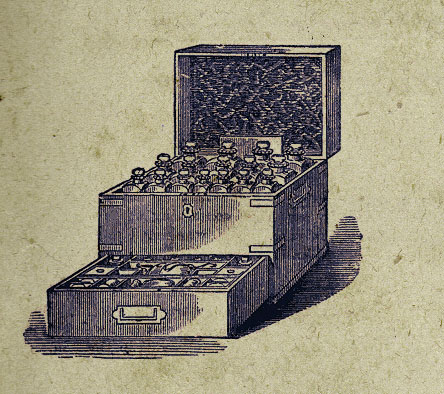A Victorian medicine chest is described along with common contents and how to use them. This certainly provides a sharp contrast to what kind of supplies are kept in household medicine cabinets today. The article was originally published in 1887 of the Good Housekeeping magazine.
Every family should be supplied with a small medicine chest, especially in the country where the drug store cannot be promptly reached or a doctor visited. These chests can be bought at prices ranging from $3 to $25, according to size, kind of material used and beauty of finish. They contain square, velvet-lined compartments into each of which a square bottle with a ground-glass stopper is fitted. Beneath is a drawer for salves, plasters and medicines in a dry state. You can make your own chest, if handy with tools and disposed to be economical.
I have had such a chest in use for twenty years. It has paid me over and over, and has often spared me great anxiety of mind. It contains six four-ounce bottles in which I keep Jamaica ginger, camphor, sweet spirits of nitre, a mixture of sweet oil and lime water, etc. ; it also contains six two-ounce vials filled with laudanum, paregoric, hive syrup, arnica, etc. In the drawer I keep chlorate of potash, sugar of lead, court plaster, ready-spread mustard plaster, lint, a wad of cotton, etc. Every article is plainly labeled, and thus I have at hand many of the remedies most needed in ordinary emergencies.
It does not require a great knowledge of medicine to know what to use for the, ordinary ailments of the human family, especially for the younger members. In cases of fever a teaspoonful of sweet spirits of nitre in a glass of water taken in small sips at short intervals is most excellent. A relief for scalds, burns, poison ivy, etc., will be found in an external application of sweet oil and lime water. Jamaica ginger is used for cramps in the stomach. Sugar of lead water used externally will reduce swellings in the limbs. Hive syrup is given for croup. Arnica is rubbed on sprains, bruises, insect bites, etc. Chlorate of potash is used for sore throat.
Of course, if the case is a serious one, a physician should be promptly consulted; but during the interval these simple remedies can be intelligently used, and such prompt and intelligent use is often of great service previous to the arrival of the physician. More than one physician has said to me, in substance, “you have checked the disease in its early stage ; I have little to recommend beyond what you have already done.”
My wife and myself have been alarmed scores of times by symptoms of fever or croup in our children on a mid-winter midnight, the nearest physician five miles away. In almost every instance by giving the little patient sweet spirits of nitre for the fever, or hive syrup for the croup, we found the child much better in the morning, our fears allayed, and the visit of a physician unneeded. These statements, borne out by a long experience, should be sufficient to extend the introduction of the family medicine chest. I have found it of such great use to me, in a practical, beneficial and economical way, that I am urged to call the attention of others to its merits.

